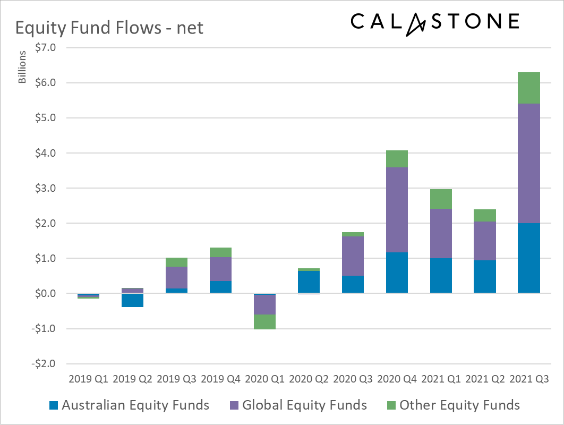
Australians plough record new capital into funds in the third quarter: Calastone
Australian investors added record amounts of new capital to managed funds during the third quarter, according to the latest Fund Flow Index (FFI) from Calastone, the largest global trading network for managed funds. Enthusiasm waned markedly as the quarter progressed, however, as Covid lockdowns were extended and the Australian stock market began to fall.
Q3 saw largest net inflows on Calastone’s record
Australians committed $6.3bn of new capital to equity funds between July and September, half as much again as the previous high point reached in the fourth quarter of 2020 when vaccine approvals unleashed a wave of global optimism. Investors were noticeably keener to place new money in funds investing overseas, as developed economies abroad began to reopen on the back of successful vaccination programmes. More than two thirds (68%) of the new Q3 capital was invested in funds focused on international equities, up from three fifths (61%) in the second quarter. Even so this still demonstrates a significantly greater domestic bias than among, say, UK investors. Calastone’s data shows British investors have placed more than 90% of their equity fund purchases in international equities over the last few years. Favourable tax treatment for domestic Australian equities helps explain the discrepancy.

Seismic shift to ESG funds in Q3
It was a big quarter for ESG funds, which garnered their largest ever share of equity inflows. $1 in every $4 of net inflows to equity funds was committed to those with an ESG focus. The total of $1.6bn was almost double the combined inflow during every quarter since the beginning of 2019. Soaring inflows to ESG funds also boosted the actively managed segment, which took in $8.40 in every $10 of equity inflows in Q3, compared to the longer run average of $7.40.

Managed Funds gain $15.7bn on Q3 across all asset classes
Across all asset classes, Australians added a net $15.7bn in the third quarter, more than doubling the previous high point on Calastone’s record, set in Q4 2020. Alongside the highest inflows yet to equity funds, mixed assets and fixed income also saw the largest inflows on Calastone’s record between July and September. Meanwhile, optimism on real estate also improved, having dwindled during the second quarter. Investors added $543m to property funds, in line with the average for the last year but significantly better than the more subdued second quarter ($450m).
The picture changed markedly as the quarter progressed. Global stock markets rose throughout July and August, while the ASX reached a new record by the middle of the quarter. Investors accordingly front-loaded their purchases, buying more enthusiastically while markets were rising. Half the new money ($3.1bn) was invested in July alone. September, meanwhile, which saw the ASX fall sharply and global markets trade sideways, saw just one fifth of the quarter’s new capital committed to funds. Even so falling share prices did not prove to be a significant deterrent. By the standards of the last three years, September was still a very good month for equity funds, with inflows around double the monthly average.
Over the third quarter as whole, Calastone’s FFI:Equity jumped to an extraordinarily high 62.6, which means that the value of buy orders outgunned sells by an astonishing 1.7:1. In Q2, the ratio was just 1.3:1.
Ross Fox, Head of Australia and New Zealand at Calastone, commented, “We expected solid inflows in the third quarter, but we have been surprised by the enormous volume of new capital flooding into funds, particularly given a troubling news agenda. The Australian economy almost certainly shrank in the third quarter as protracted lockdowns in NSW and Victoria curtailed activity, and the wider global economic recovery decelerated too. Stock markets around the globe have faltered on concerns over rising inflation and higher bond yields, energy supply constraints and falling industrial production in China.
“Yet our national household savings ratio remains far above historic levels and a lot of that cash is finding its way into funds. What’s more, global demand is strong and Australia’s economy should return to growth in the fourth quarter. With vaccination rates surging in Q3 and restrictions easing, it seems that Australians have looked beyond the immediate troubles, considered the bigger picture and felt reassured.
“We are particularly interested in the big inflow to ESG funds. Australia has lagged a long way behind its global peers in this area over the last two years, but this may be the beginning of the catch up. In the UK, almost $6 in every $10 invested in equity funds in the last two years has been committed to ESG funds, compared to just $1.30 in Australia. Q3 marked a step change. Experience overseas suggests the acceleration has a long way to run. ESG funds tend to be global in nature, so sustained growth in ESG funds may also rebalance flows towards international equities.”


